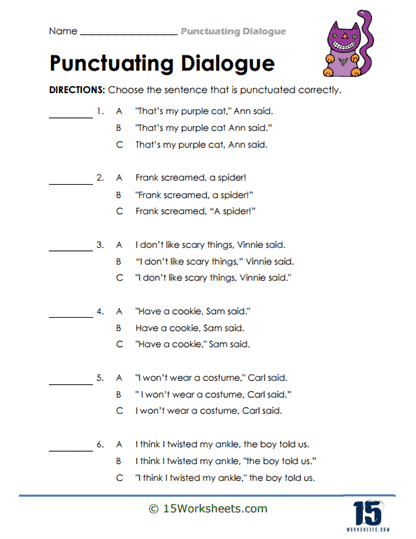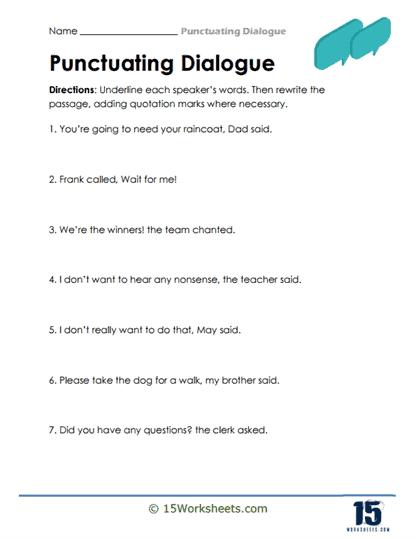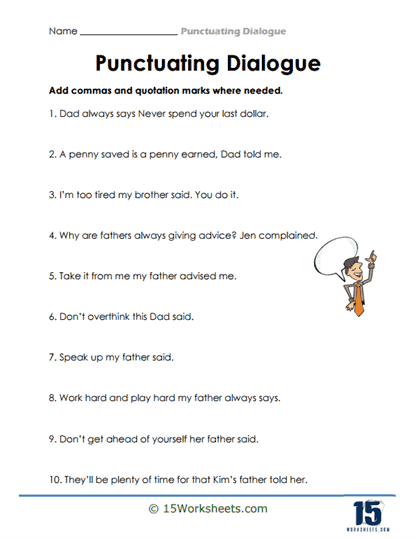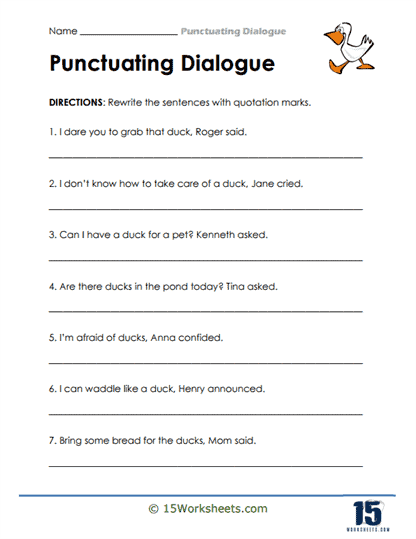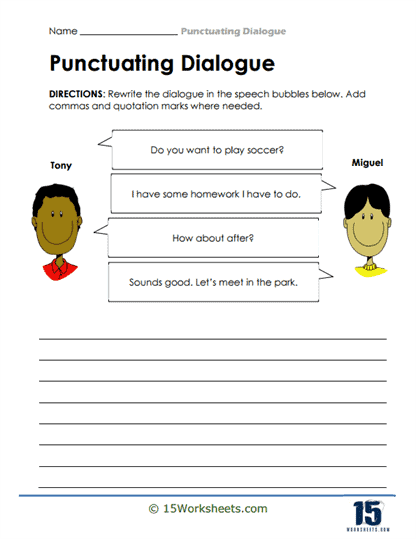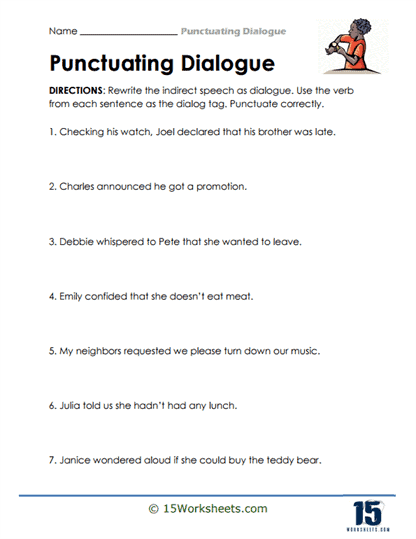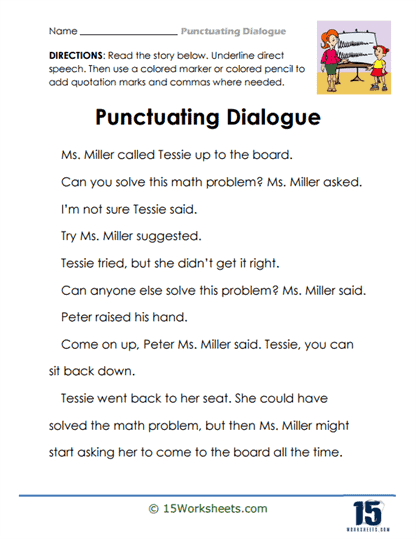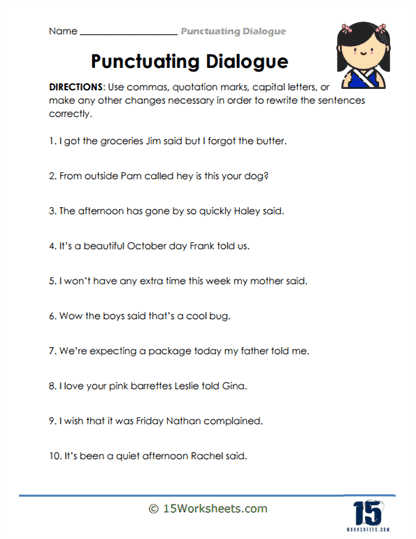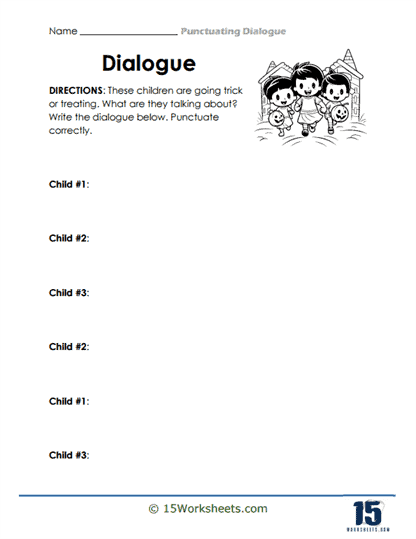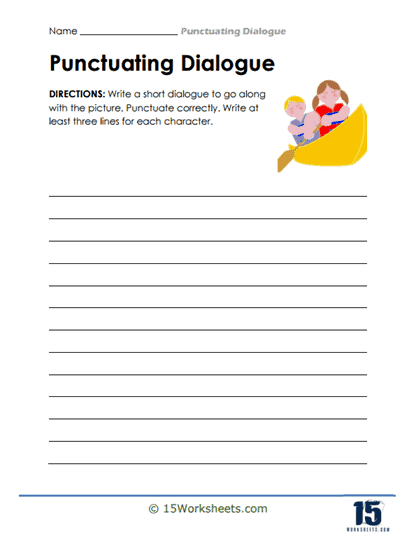Punctuating Dialogue Worksheets
About These 15 Worksheets
These worksheets serve a pivotal role in educating students about the proper use of punctuation marks within dialogues. The primary objective is to familiarize students with the rules and conventions governing the placement of quotation marks, commas, periods, and other punctuation marks within speech and conversation. By mastering these rules, students not only become more proficient writers but also more effective readers who can navigate written dialogues with ease and comprehension.
Punctuation is the silent conductor in the orchestra of written language, guiding readers through the rhythm and melody of words. In the realm of creative writing and storytelling, punctuating dialogue effectively is a crucial skill. To nurture this skill and help students grasp the nuances of dialogue punctuation, educators often employ Punctuating Dialogue Worksheets. These worksheets are invaluable resources designed to enhance students’ understanding of grammar, good writing practices, and reading comprehension. In this essay, we will explore the purpose of Punctuating Dialogue Worksheets, the various types of exercises they encompass, and how practicing with them can aid students in improving their language skills through active engagement.
The primary objective is to familiarize students with the rules and conventions governing the placement of quotation marks, commas, periods, and other punctuation marks within speech and conversation. By mastering these rules, students not only become more proficient writers but also more effective readers who can navigate written dialogues with ease and comprehension.
Types of Exercises
Quotation Mark Placement – In this fundamental exercise, students are presented with sentences or short dialogues and are tasked with correctly placing quotation marks around the spoken words. They must learn the difference between direct and indirect speech and apply the appropriate punctuation accordingly. For example:
Correct – “I love reading,” she exclaimed.
Incorrect – I love reading, she exclaimed.
Dialogue Tags and Punctuation – This exercise involves sentences where dialogue tags (e.g., “he said,” “she whispered”) accompany the spoken words. Students must punctuate the dialogue correctly by placing quotation marks around the speech and incorporating the dialogue tag smoothly with appropriate punctuation. For example:
Correct – “Let’s go to the park,” he said.
Incorrect – “Let’s go to the park.” He said.
Punctuating Interruptions – Dialogues often include interruptions or interjections. Students learn how to punctuate these interruptions effectively, understanding when to use em dashes, ellipses, or parentheses to convey the flow of the conversation. For example:
Correct – “I was thinking we could go to the mov—”
“Absolutely not!”
Incorrect – “I was thinking we could go to the mov…”
“Absolutely not!”
Multiple Speakers – In this exercise, students encounter dialogues involving multiple speakers, requiring them to distinguish between different speakers’ lines and punctuate them accordingly. This exercise reinforces the use of new paragraphs or indentations for each speaker. For example:
Correct: Alice said, “I love hiking.” Bob replied, “Me too! Let’s plan a trip.”
Incorrect: Alice said, “I love hiking.” Bob replied, “Me too! Let’s plan a trip.”
Correcting Punctuation Errors – Students are provided with sentences containing punctuation errors in dialogue. They must identify and rectify these errors, ensuring proper quotation mark placement, comma usage, and punctuation consistency. For example:
Incorrect – “I can’t believe you said that.!”
Correct – “I can’t believe you said that!”
Converting Narration into Dialogue – This creative exercise encourages students to transform a narrative passage into a dialogue format. By doing so, they gain a deeper understanding of how dialogue can be used to convey character interactions and plot developments effectively. Worksheets may include excerpts from literary works or short stories, asking students to analyze the dialogue for punctuation patterns and their impact on character development and storytelling. This exercise combines reading comprehension with a focus on dialogue punctuation.
The Benefits of These Worksheets
Enhances Grammar Proficiency – By engaging with various dialogue punctuation exercises, students develop a solid grasp of punctuation rules, such as where to place quotation marks, how to punctuate dialogue tags, and how to handle interruptions. This enhanced grammar proficiency extends to other areas of writing, promoting better overall language skills. Proper dialogue punctuation ensures that readers can discern spoken words from narrative elements. As students become adept at punctuating dialogue, their own writing becomes clearer, more engaging, and easier to follow.
Develops Critical Reading Skills – Analyzing dialogue excerpts from literature prompts students to closely examine punctuation choices made by skilled authors. This encourages critical reading and helps students understand how punctuation contributes to character development, tone, and narrative structure. These worksheets engage students in active learning, encouraging them to apply punctuation rules actively. This hands-on approach aids in the retention of knowledge and ensures that students can use these skills in their writing and reading. Punctuating dialogue requires a keen eye for detail, as small punctuation marks can significantly impact the meaning and flow of a conversation. This attention to detail cultivated through worksheets can benefit students in various academic and professional contexts.
Encourages Effective Communication – Proper dialogue punctuation is essential for effective communication in written form. As students master this skill, they become more confident communicators in both their writing and interpersonal interactions. Reading dialogues punctuated correctly allows students to follow character interactions and plot developments more effectively. This reinforces reading comprehension and encourages students to engage deeply with texts.
Prepares for Real-World Writing – Effective dialogue punctuation is valuable not only in creative writing but also in professional and academic contexts. Students who practice with these worksheets are better equipped for success in various communication scenarios, from business emails to research papers. As students practice and become more proficient in punctuating dialogue correctly, they gain confidence in their writing abilities. This newfound confidence can inspire them to explore more complex writing projects and take on creative challenges.





